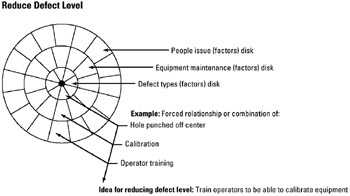Tool 34: Circumrelation
| AKA | Forced Relationship Method |
| Classification | Idea Generating (IG) |
Tool description
The circumrelation method is an idea generation tool developed by Frank Laverty. Using three freely spinning disks, each with factors recorded in respective sections, forced relationships are possible by rotating the disks so that different factors, one from each disk, are lined up to form a combination of factors. Combinations are evaluated for useful ideas or potential solutions.
Typical application
-
To examine related problem factors by combining three different factors at a time in an attempt to produce some ideas for problem resolution.
-
To discover novel ideas for process improvement.
-
To utilize a systemic approach to problem solving.
Problem-solving phase
| → | Select and define problem or opportunity |
| → | Identify and analyze causes or potential change |
| Develop and plan possible solutions or change | |
| Implement and evaluate solution or change | |
| Measure and report solution or change results | |
| Recognize and reward team efforts |
Typically used by
| Research/statistics | |
| 1 | Creativity/innovation |
| Engineering | |
| Project management | |
| Manufacturing | |
| 3 | Marketing/sales |
| Administration/documentation | |
| Servicing/support | |
| Customer/quality metrics | |
| 2 | Change management |
before
-
Problem Specification
-
Brainstorming
-
Phillips 66
-
Brainwriting Pool
-
Focus Group
after
-
Criteria Filtering
-
Run-It-By
-
Different Point of View
-
Consensus Decision Making
-
Wildest Idea Technique
Notes and key points

-
For individual or team idea generation.
-
A basic circumrelator has three disks measuring 3, 5, and 7 inches in diameter. A fourth disk is optional.
-
Disks are divided into 8, 12, and 16 sections. Multiplying 8 12 16 = 1536 factor combinations or forced relationships.
Step-by-step procedure
-
STEP 1 The team (or individual) reviews the previously specified problem.
-
STEP 2 Three major areas related to the problem are identified. See example Circumrelation: Reduce Defect Level. People issues, equipment maintenance, and defect types are all related to a reduce defect level.
-
STEP 3 The team brainstorms factors for each major area. This process is continued until the team stops generating factors.
-
STEP 4 Using the nominal group technique (NGT), the team reduces the number of generated factors in each major area to 8-12-16.
-
STEP 5 Factors are now recorded in the sections of the three major areas on the three disks.
-
STEP 6 The search for idea-producing combinations calls for the rotation of one disk at a time, lining up different combinations (forced relationships).
-
STEP 7 The team assesses all combinations and records any ideas that warrant further consideration in order to solve the problem. See idea in example shown.
Example of tool application

EAN: 2147483647
Pages: 326